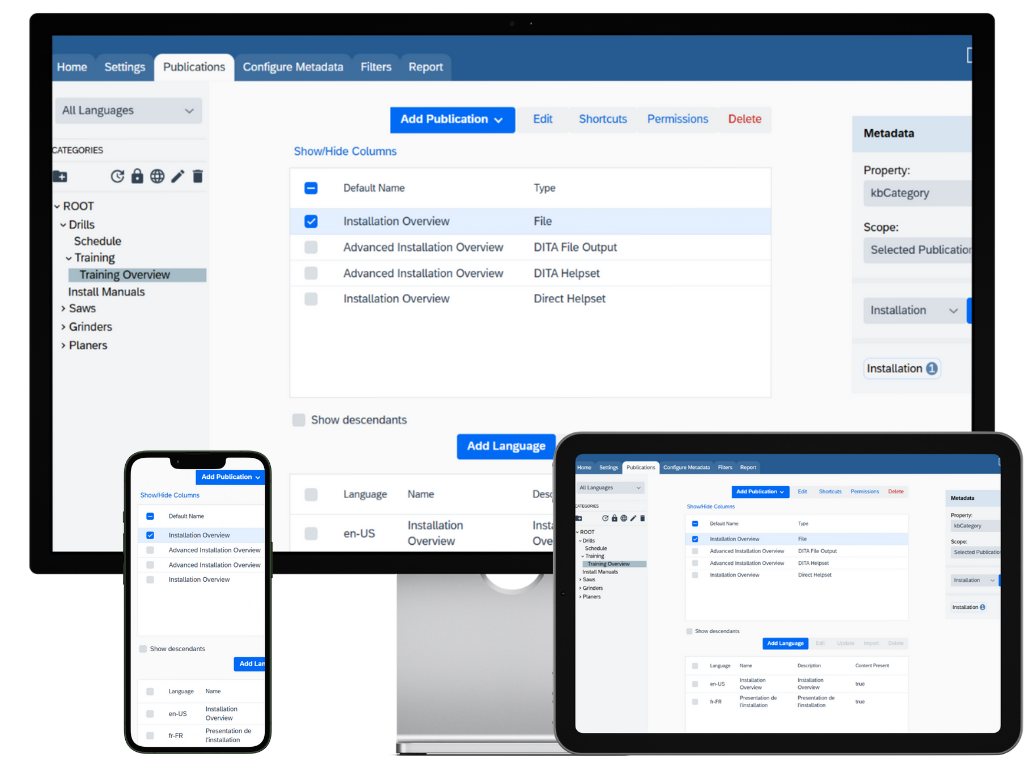In today’s world support content requires efficient content delivery to secure business goals. A database-driven publishing tier provides numerous benefits that streamline operations, enhance content management, and reduce costs.
Faster Deployment Time
In addition to faster deployment, a database-driven publishing tier facilitates the rapid publishing of new content. Content creators can use intuitive interfaces to input, edit, and manage content directly within the database. This eliminates the need for technical expertise or reliance on developers to publish new material.
The system can be configured to automatically format and display content based on predefined templates, ensuring consistency and brand adherence across the platform. Workflows can be further streamlined by implementing approval processes, allowing designated users to review and approve content before it goes live. This combination of user-friendly interfaces, automated formatting, and approval workflows empowers content teams to publish new content quickly and efficiently, maximizing audience engagement and driving traffic to the platform.
Rapid Publishing of New Content
One of the most significant advantages of a database-driven publishing tier is the accelerated deployment time for new content and platform updates. Traditional publishing workflows often involve manual processes, such as coding changes directly into website files or using static content management systems. These methods can be time-consuming and prone to errors, especially when dealing with complex content structures or large volumes of data.
A database-driven approach centralizes content storage and management, allowing developers to create dynamic templates that automatically pull data from the database.
This means that new content can be added or updated simply by modifying the database, without the need to alter the underlying code or redeploy the entire platform. The capacity to swiftly generate final outputs and implement updates with minimal manual intervention is particularly advantageous when modifications to the database occur. This significantly reduces deployment time, enabling organizations to respond quickly to market demands and deliver timely information to their audience.
Lower Costs
Implementing a database-driven publishing tier can lead to significant cost savings in several areas. The reduced deployment time and streamlined content publishing processes translate to lower labor costs. Developers can focus on more strategic tasks, while content creators can independently manage the publishing workflow.
Flexible Configuration and Permissions
A database-driven publishing tier offers granular control over configuration and permissions, enabling organizations to tailor the platform to their specific needs. User roles and permissions can be defined within the database, allowing administrators to control who has access to specific content, features, and functionalities.
- Permissioned Content: This is particularly useful for creating permissioned content, where access is restricted based on user roles or subscriptions. For example, premium content can be made available only to paying subscribers, while internal documents can be restricted to employees within a specific department.
- Commenting Configuration: Similarly, commenting configurations can be managed through the database, allowing administrators to control who can post comments, moderate discussions, and flag inappropriate content. This level of control helps foster a positive and engaging community environment while minimizing the risk of abuse or misinformation.
- Compliance and Security: Organizations that need to comply with internal data standards and industry-specific or government regulations might prefer an on-premises database setup because of the ease of visibility into those systems. On-premises platforms enable DBAs, compliance managers and other involved personnel to more easily provide supporting evidence of compliance to auditors.
Conclusion
A database-driven publishing tier offers a compelling solution for content delivery platforms seeking to improve efficiency, reduce costs, and enhance content management. By centralizing content storage, automating publishing workflows, and providing granular control over permissions, this approach empowers organizations to deliver timely, relevant, and engaging content to their audience. In today’s competitive digital landscape, a database-driven publishing tier can be a key enabler of success, driving audience engagement, increasing brand loyalty, and achieving business objectives.
At Bluestream, we are committed to providing exceptional technology and expertise to help organizations overcome their product documentation challenges and achieve their goals efficiently.
Partner with us today to unlock the full potential of your documentation and enhance your overall productivity.
Follow us on LinkedIn for more of our news and announcements.


